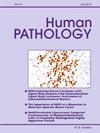PAX5作为非常规急性白血病的诊断工具:建立b细胞谱系的免疫组织化学证据。
IF 2.6
2区 医学
Q2 PATHOLOGY
引用次数: 0
摘要
急性白血病谱系分配是临床管理的关键。当流式细胞术检测到CD19表达不清时,就很难满足b淋巴母细胞白血病/淋巴瘤(B-ALL)或b -谱系混合表型的标准。虽然许多b系特异性标记可通过免疫组织化学(IHC)获得,但它们尚未得到系统验证。本研究强调了PAX5, BOB.1和OCT2在CD19暗淡时谱系分配中的作用,允许考虑作为额外的诊断标准。我们检索了两个学术机构的数据库:急性未分化白血病(acute undifferentiated leukemia, AUL)、轻度分化急性髓系白血病(acute myeloid leukemia, AML)、混合表型急性白血病(mixed phenotype acute leukemia, MPAL)和所有cd19弱表达的急性白血病。采用PAX5、BOB.1、OCT2染色。通过细胞强度和阳性细胞百分比对ihc进行评分。CD19弱表达55例:B-ALL 18例,急性白血病37例(MPAL 14例)。作为阴性对照,我们选择了21例分化最小的AML, 5例T/髓系病例,5例接近早期T细胞前体(ETP) T- all和3例ETP T- all。PAX5免疫组化18/18 (100%)B-ALL阳性;所有小分化髓系和T/髓系白血病均为阴性(0/26),36/37(98%)急性弱CD19白血病为阳性。我们的多中心数据支持PAX5 IHC在CD19昏暗至阴性时作为b谱系分配的敏感标志物,特别是在具有模糊谱系或MPAL的急性白血病中。BOB.1和OCT2也有帮助,但灵敏度较低。在CD19与弱CD79a和/或CD22暗淡的情况下,PAX5 IHC可以“拯救”谱系分配。本文章由计算机程序翻译,如有差异,请以英文原文为准。
PAX5 as a diagnostic tool in unconventional acute leukemia: Establishing immunohistochemical evidence of B-cell lineage
Acute leukemia lineage assignment is critical for clinical management. When CD19 expression is dim by flow cytometry, it becomes challenging to meet criteria for B-lymphoblastic leukemia/lymphoma (B-ALL) or B-lineage in mixed phenotype. While many B-lineage specific markers are available by immunohistochemistry (IHC), they have not been systematically validated. This study highlights the utility of PAX5, BOB.1 and OCT2 in lineage assignment when CD19 is dim, allowing for consideration as additional diagnostic criteria.
The databases of two academic institutions were searched for cases: acute undifferentiated leukemia (AUL), acute myeloid leukemia (AML) with minimal differentiation, mixed phenotype acute leukemia (MPAL), and all acute leukemias with weak CD19-expression. Cases were stained with PAX5, BOB.1 and OCT2. The IHCs were scored by intensity and percentage of positive blasts.
A total of 55 cases had weak CD19 expression: 18 B-ALL and 37 acute leukemias with weak CD19-expression (14 MPAL). For negative controls, we selected 21 AML with minimal differentiation, 5 T/myeloid cases, 5 near early T-cell precursor (ETP) T-ALLs and 3 ETP T-ALLs. By PAX5 IHC, 18/18 (100 %) B-ALL cases were positive; all minimal differentiation myeloid and T/myeloid leukemias were negative (0/26), and 36/37 (98 %) acute leukemias with weak CD19 were positive.
Our multicenter data support PAX5 IHC as a sensitive marker of B-lineage assignment when CD19 is dim to negative, especially in acute leukemias with ambiguous lineage or MPAL. BOB.1 and OCT2 can also be helpful but these demonstrated lower sensitivity. In cases where CD19 is dim, with weak CD79a and/or CD22, PAX5 IHC can “rescue” the lineage assignment.
求助全文
通过发布文献求助,成功后即可免费获取论文全文。
去求助
来源期刊

Human pathology
医学-病理学
CiteScore
5.30
自引率
6.10%
发文量
206
审稿时长
21 days
期刊介绍:
Human Pathology is designed to bring information of clinicopathologic significance to human disease to the laboratory and clinical physician. It presents information drawn from morphologic and clinical laboratory studies with direct relevance to the understanding of human diseases. Papers published concern morphologic and clinicopathologic observations, reviews of diseases, analyses of problems in pathology, significant collections of case material and advances in concepts or techniques of value in the analysis and diagnosis of disease. Theoretical and experimental pathology and molecular biology pertinent to human disease are included. This critical journal is well illustrated with exceptional reproductions of photomicrographs and microscopic anatomy.
 求助内容:
求助内容: 应助结果提醒方式:
应助结果提醒方式:


